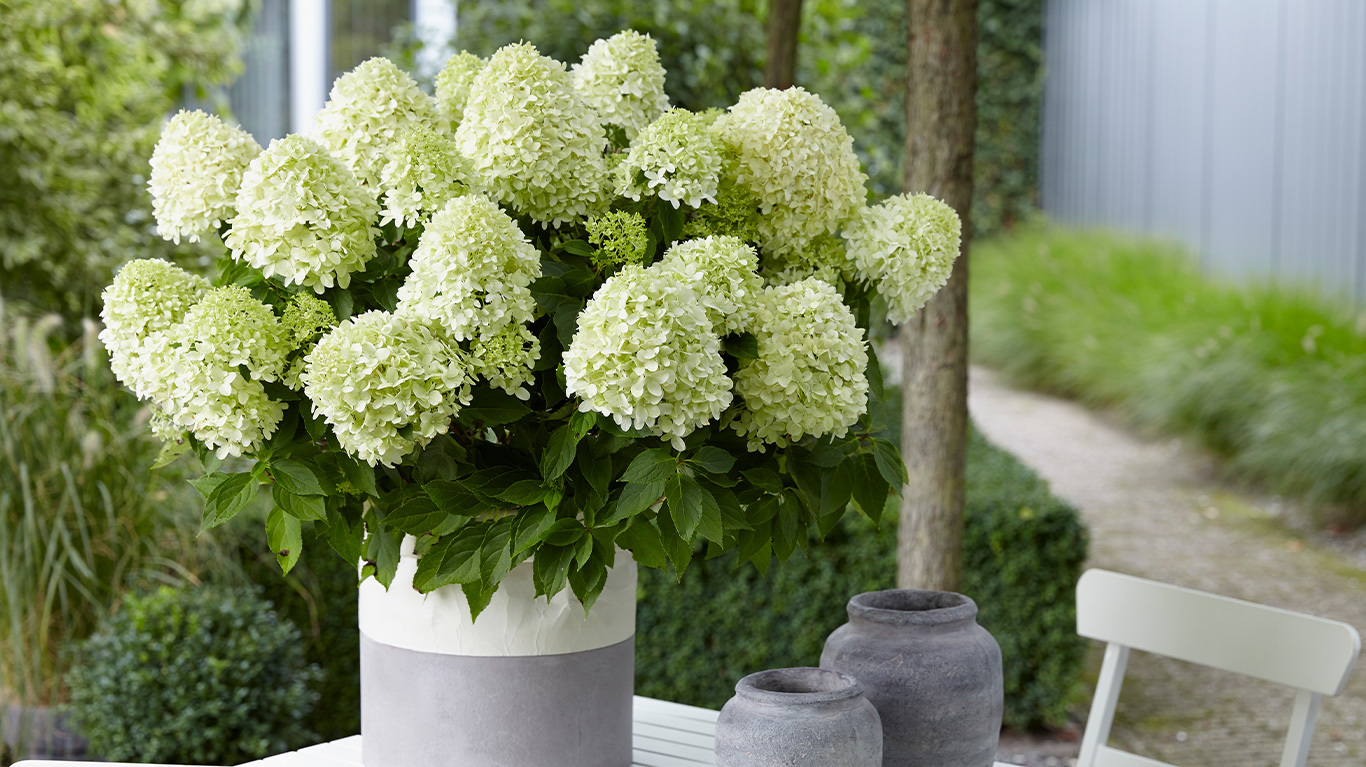
What We've Included
About | How to Grow | How to Plant | Hydrangea Care | Deadheading | Watering | Fertilising | Winter Protection | Pruning | Problem Solving | How to Change the Colour of Hydrangea Flowers
About Hydrangeas
You'll be thrilled to learn that in addition to the many elegant shrubby hydrangeas, gardeners can also grow beautiful climbing hydrangeas which are self-clinging so no support is required. Although they can take two or three years to settle down after being planted because they are slow-growers, after their first year you can expect strong luxuriant growth and spectacular flowers in subsequent seasons.
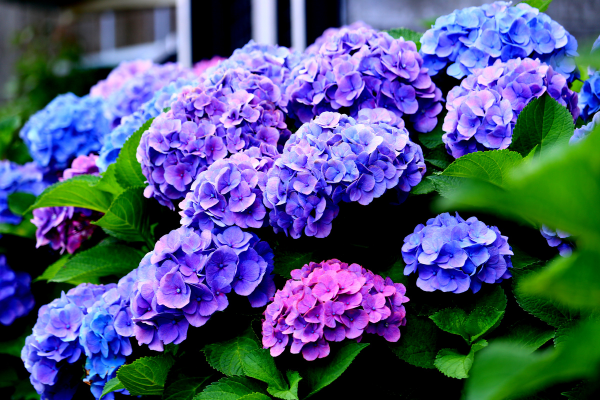
Climbing hydrangeas
Hydrangea anomala subsp. petiolaris is amongst the most popular climbing hydrangea. It’s hardy, easy to grow and will thrive in most North-facing gardens as well as South, East and West. It can grow quite large, so be sure to give it plenty of room. Large showy, white lace-cap flowers smother the plant from June to August and like most deciduous shrubs, it loses its leaves in winter. Height and spread: 15m x 3m.
Some climbing hydrangeas are ideal when grown against shady North or East-facing walls where other climbers won’t flourish and with appealing deep-veined dark green foliage, climbing hydrangeas are smothered in blowsy flowers in summer.
Most climbing hydrangeas enjoy full sun to partial shade, like fertile, well-drained soil and are winter-hardy down to -15ºC/-20ºC so are a great option for chilly Northern gardens. Expect them to reach between 5m-15m when fully grown depending on the variety.
For gardeners looking for something unusual and exotic, there are two fabulous evergreen climbing hydrangeas well worth considering, however, both require sheltered, warm spots to grow well. Evergreen hydrangeas earn their stripes in providing privacy all year round so are fantastic for masking party walls, ugly eyesores or shabby outbuildings.
Hydrangea seemannii comes from Mexico and has a longer flowering period from June to September when it explodes with domed blue flower-heads circled by pure white bracts. It’s no surprise you’ll need to plant it somewhere warm, well out of the way of strong or cold winds and although it prefers South, West or East–facing gardens, it thrives happily in fertile, well-drained, soil in sun or partial shade.
Height and spread: 12m x 4m
Originally from Chile and Argentina, Hydrangea serratifolia is ideal for smaller gardens with handsome, leathery evergreen leaves and a profusion of charming panicles of creamy-white flowers up to 15 cm from July to August. South, West or East–facing spots are best in full sun to partial shade.
Height and spread: 5m x 4m
Hydrangea Shrubs
Hydrangea shrubs come in many different colours and are loved for their sumptuous blooms and pastel-hued shades. One of the most appealing features of shrubby hydrangeas is their sheer versatility, they can be used as focal border plants, planted en-masse to line paths or driveways, always earn their stripes in mixed perennial gardens and look wonderful in large containers on the patio.
How to Grow Hydrangea
To grow shrubby hydrangeas, you’ll need to provide a space that gets plenty of sunshine, although most will cope with light shade. Bear in mind that although some are recommended for North-facing areas, flowering is reduced in shade.
Soil should be moist but well-drained and once the shrubs are planted, water them regularly. Fertilise them once a year when you first see the flower buds appear with a potassium feed, any tomato fertiliser will do.
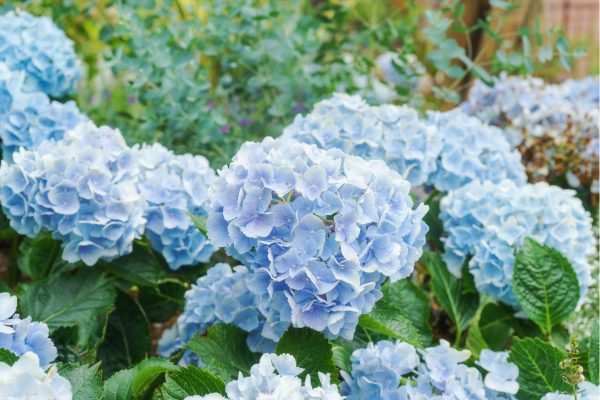
How to Plant
Hydrangeas are best planted in spring or autumn. There are a few things to consider when planting hydrangeas to ensure they get the best start in life and always look their best.
For the best flower displays, choose a sunny spot as hydrangeas need at least six hours of sunlight a day if you want an abundance of blooms.
Water the potted plant before planting.
Dig a hole that is twice as wide and deep as the pot the hydrangea is currently in. Add a handful of well-rotted organic matter to the bottom of the hole and be sure to remove all surrounding weeds as well as rocks and debris from the hole before planting.
Place the hydrangea in the planting hole and fill it in with soil, making sure to firm it down well.
Finally, water the plant again.
Hydrangea Care
The spectacular blooms of hydrangeas are undeniably a favourite of gardeners everywhere. Here are a few useful tips to get the most from them.
Hydrangeas are thirsty and need plenty of water. Be sure to water them regularly, especially during hot weather or prolonged dry spells.
Give them an annual feed by using organic, slow-release rose fertiliser, or mulch the base of plants with organic matter in spring.
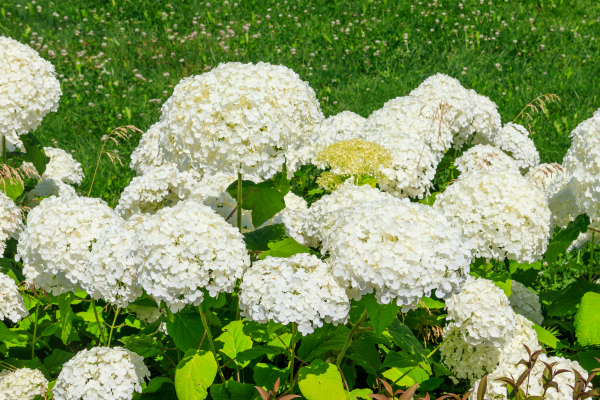
Do you need to deadhead hydrangeas?
Although many gardeners feel the need to deadhead hydrangeas to keep the garden looking tidy, deadheading hydrangeas isn’t essential. Many gardeners enjoy the skeletal beauty of the faded flowerheads touched by frost in the winter garden and the spent flowers also help protect the plant against frosts and snowfall.
Watering
Water hydrangeas regularly rather than sporadic drenching with a watering can or hose. During heat waves or prolonged dry periods, you might need to water your plants daily since their roots dry out quickly, especially in pots.
Fertilising
Fertilising is the process of adding nutrients to the soil which plants absorb through their roots to make leaves and flowers. Using organic matter such as leaf mould or well-rotted manure feeds the plant, helps trap moisture in the soil, attracts heat that boosts root growth and improves soil structure. Artificial or chemical fertilisers feed the plant but do little to improve the soil and are easily washed by rainfall or watering. Apply a 2.5 cm thick mulch of organic material around the plant base each spring.

Winter Protection
Hydrangeas need no winter protection since they are very hardy plants. Many gardeners leave the spent flower heads over winter to add seasonal interest and they also add a measure of protection against plummeting temperatures.
How to Prune
Pruning hydrangeas helps to keep them at a manageable size and gives them a good overall shape. It also removes any unsightly or damaged stems and results in a better display of flowers by stimulating the plant to produce new shoots. However, if you prune your plants at the wrong time of year it can drastically affect the number of flowers they produce in summer, so it’s important to understand when and how to prune hydrangeas.
If you are unsure about what type of hydrangea you’re growing, simply wait for the hydrangea to flower in summer and prune it the following year. Don’t worry, leaving a hydrangea unpruned for a year or two doesn’t do it any harm.
Most hydrangeas are pruned in late winter or spring, except climbing hydrangeas, which can be pruned in summer after they have finished flowering. Different types of hydrangeas need different pruning methods and it’s easy to identify the different types of hydrangeas from their flower shape: mophead and lace-cap.
Mophead blooms are the more common type, easily identified since the flowers are round and full and are pruned in late spring.
Lacecap flowers tend to be smaller and more delicate and are usually pruned in either autumn or spring.
How to Prune a mophead Hydrangea
To prune a shrubby mophead hydrangea, remove any dead, damaged or crossing stems.
On older plants, you can cut back one or two old stems to ground level to encourage the plant to produce new growth.
Deadhead old flowers if you don’t want to keep them for winter interest, then use a clean sharp pair of secateurs to cut back stems to the first pair of strong buds below each flower.
How to prune a shrubby lace-cap hydrangea
To prune a shrubby lace-cap hydrangea, remove any dead, damaged or crossing stems.
On established plants, cut back one or two old stems to ground level to encourage the plant to produce new growth.
Deadhead old flowers, cutting back to the second pair of buds below a flowerhead
Pruning Other Hydrangeas
Climbing hydrangeas are pruned differently from shrubby hydrangeas and since climbers are slow-growers, you rarely have to prune them at all in the first 2-3 years after planting. Once they reach 10m or more, you’ll need to prune them to maintain their size, shape and spread or just leave them to go their own way.
Prune as soon as the flowering is over in the summer to avoid the risk of cutting off any new flower buds.
Shorten any straggling shoots, cutting back to a lower pair of healthy strong buds. Try to avoid pruning too much off the top of the plant, as this is where most of the flowers will appear.
Pruning Mature Hydrangeas
If you've inherited a tall, unruly established climbing hydrangea, prune it in spring. Sometimes it's necessary to prune them hard because they have become unmanageable or outgrown their space. That’s fine, climbing hydrangeas can cope with hard pruning but if you are reducing the size of the plant significantly, prune it gradually over 2-3 years to reduce the stress on the plant although they are likely to produce fewer flowers for a year or two afterwards.
There are a few other types of hydrangeas that can be pruned in early spring. Oakleaf hydrangeas need little pruning, just give them a general tidy-up and remove any dead flower heads.
Growing Hydrangea : Problem-solving
Generally, hydrangeas are problem-free which is one of the reasons they are so loved, but should you have trouble growing them there are a few things you can do to help solve the problem.
Make sure you plant them in the right spot. Hydrangeas need plenty of sunlight, so plant them in a sunny area of the garden.
Water them regularly, they hate drying out. Press your fingers into the soil about 3 cm deep at the base of the plant: if it’s dry to the touch, it’s time to water.
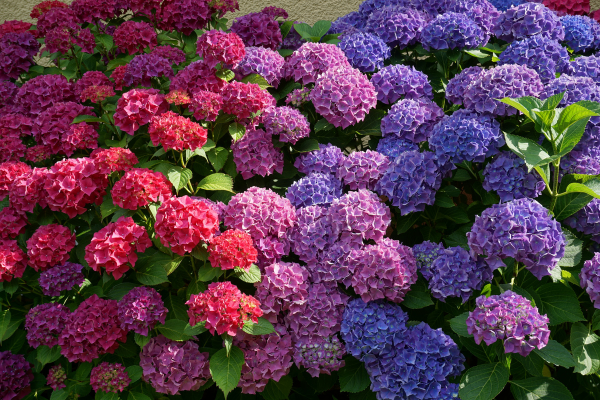
How to Change the Colour of Hydrangea Flowers
You may have bought a blue hydrangea and over time, noticed the flowers turn pink. That’s because hydrangeas typically display blue flowers on acid soils with a pH of 5.5. When grown on neutral soil (with a pH of 7), the flowers are predominantly pink, although you may also get blue-mauve blooms.
If you want to make sure that your hydrangea has blue flowers, you’ll need to make sure your pH doesn’t rise above 6.5. It’s relatively easy to lower the pH of neutral soil by treating it annually with aluminium salts. However, it can be harder to alter the pH of lime (alkaline) soil.
Employing the right plant, right place approach is so much easier and labour-saving in the long run, so we recommend you choose hydrangeas that suit your soil such as the white or pink varieties instead.
Ready to Shop?
